Engineering Management Case Study: Construction Project at HDR Company
VerifiedAdded on 2020/03/02
|21
|5042
|46
Report
AI Summary
This report presents a case study analyzing the engineering management practices of HDR Company, an architectural engineering firm. The study focuses on the challenges faced by the construction industry, including cost and time overruns, and the importance of effective planning, scheduling, and monitoring. The report details the purpose, methodology, and objectives of a construction project, emphasizing the significance of leadership, engineering practices, and risk management. It covers construction planning, work breakdown structure, and various risks associated with construction programs, along with risk management methods and material management approaches. The analysis includes design parameters, the impact of project management, Gantt and PERT charts, and concludes with learning outcomes and references. The report highlights the importance of addressing challenges like material shortages, labor issues, and financial factors to ensure project success. The study also provides detailed data analysis of activities such as earthwork, RCC work, brickwork, and more.
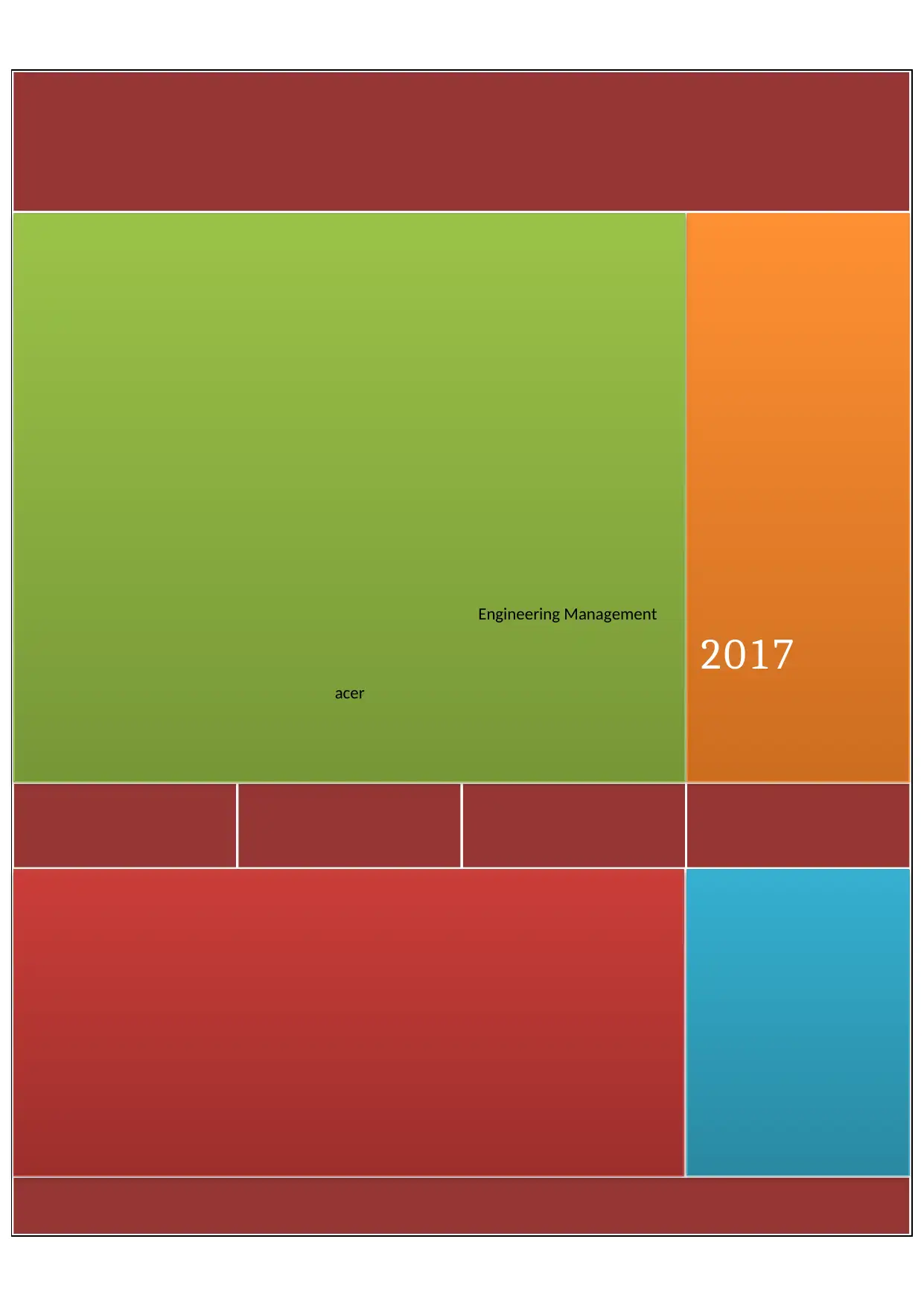
Engineering Management
acer
2017
acer
2017
Paraphrase This Document
Need a fresh take? Get an instant paraphrase of this document with our AI Paraphraser
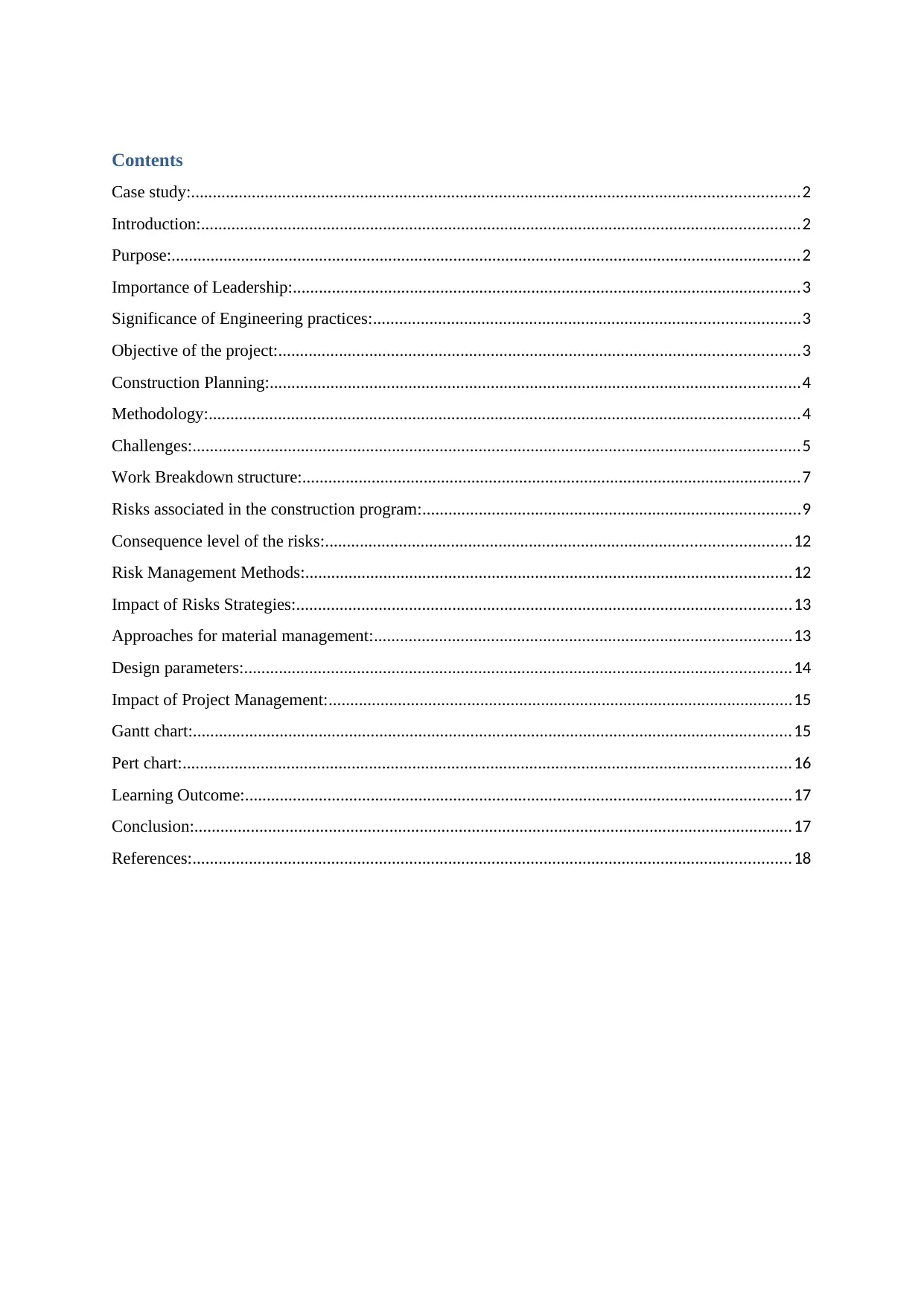
Contents
Case study:............................................................................................................................................2
Introduction:..........................................................................................................................................2
Purpose:.................................................................................................................................................2
Importance of Leadership:.....................................................................................................................3
Significance of Engineering practices:..................................................................................................3
Objective of the project:........................................................................................................................3
Construction Planning:..........................................................................................................................4
Methodology:........................................................................................................................................4
Challenges:............................................................................................................................................5
Work Breakdown structure:...................................................................................................................7
Risks associated in the construction program:.......................................................................................9
Consequence level of the risks:...........................................................................................................12
Risk Management Methods:................................................................................................................12
Impact of Risks Strategies:..................................................................................................................13
Approaches for material management:................................................................................................13
Design parameters:..............................................................................................................................14
Impact of Project Management:...........................................................................................................15
Gantt chart:..........................................................................................................................................15
Pert chart:............................................................................................................................................16
Learning Outcome:..............................................................................................................................17
Conclusion:..........................................................................................................................................17
References:..........................................................................................................................................18
Case study:............................................................................................................................................2
Introduction:..........................................................................................................................................2
Purpose:.................................................................................................................................................2
Importance of Leadership:.....................................................................................................................3
Significance of Engineering practices:..................................................................................................3
Objective of the project:........................................................................................................................3
Construction Planning:..........................................................................................................................4
Methodology:........................................................................................................................................4
Challenges:............................................................................................................................................5
Work Breakdown structure:...................................................................................................................7
Risks associated in the construction program:.......................................................................................9
Consequence level of the risks:...........................................................................................................12
Risk Management Methods:................................................................................................................12
Impact of Risks Strategies:..................................................................................................................13
Approaches for material management:................................................................................................13
Design parameters:..............................................................................................................................14
Impact of Project Management:...........................................................................................................15
Gantt chart:..........................................................................................................................................15
Pert chart:............................................................................................................................................16
Learning Outcome:..............................................................................................................................17
Conclusion:..........................................................................................................................................17
References:..........................................................................................................................................18
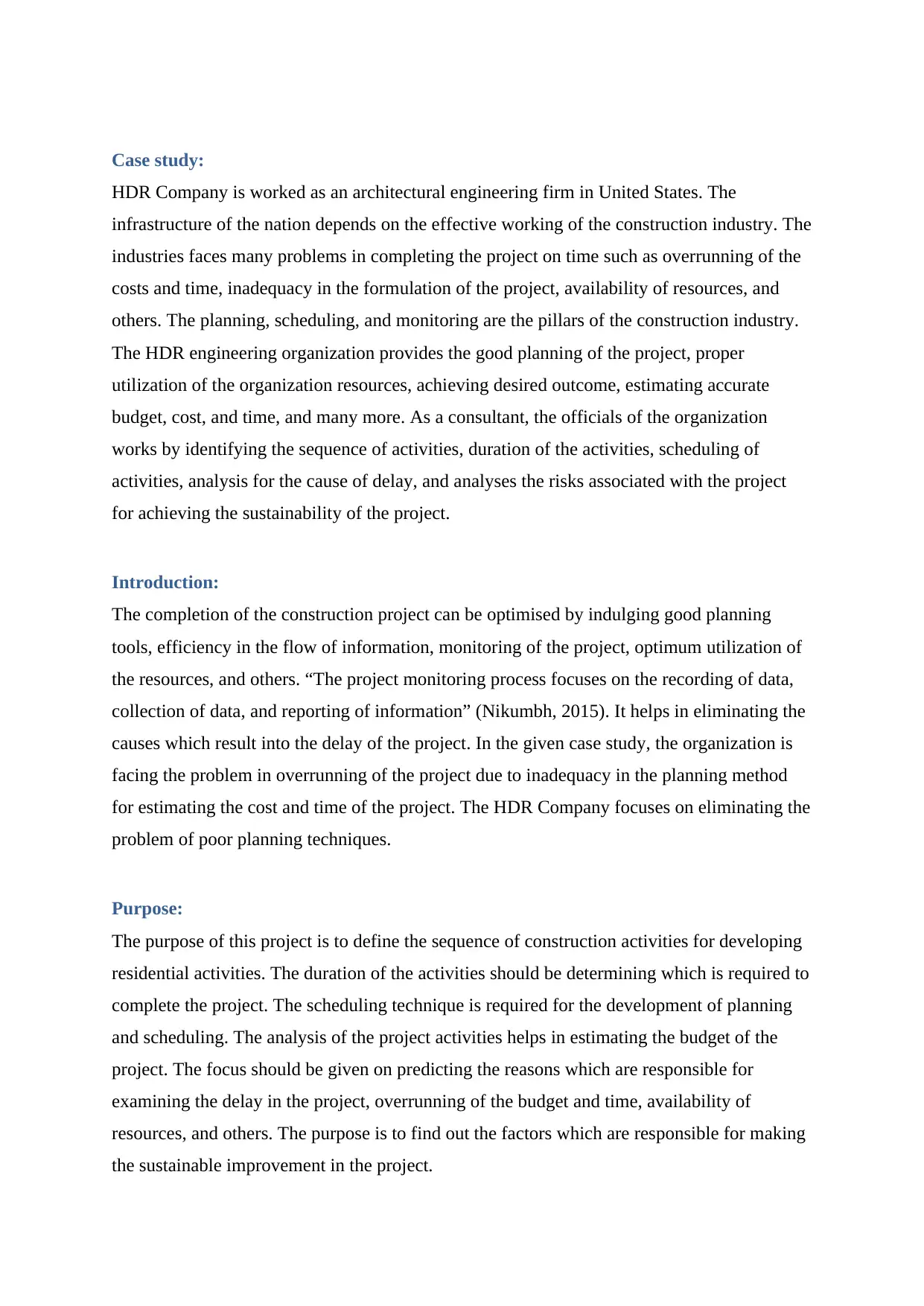
Case study:
HDR Company is worked as an architectural engineering firm in United States. The
infrastructure of the nation depends on the effective working of the construction industry. The
industries faces many problems in completing the project on time such as overrunning of the
costs and time, inadequacy in the formulation of the project, availability of resources, and
others. The planning, scheduling, and monitoring are the pillars of the construction industry.
The HDR engineering organization provides the good planning of the project, proper
utilization of the organization resources, achieving desired outcome, estimating accurate
budget, cost, and time, and many more. As a consultant, the officials of the organization
works by identifying the sequence of activities, duration of the activities, scheduling of
activities, analysis for the cause of delay, and analyses the risks associated with the project
for achieving the sustainability of the project.
Introduction:
The completion of the construction project can be optimised by indulging good planning
tools, efficiency in the flow of information, monitoring of the project, optimum utilization of
the resources, and others. “The project monitoring process focuses on the recording of data,
collection of data, and reporting of information” (Nikumbh, 2015). It helps in eliminating the
causes which result into the delay of the project. In the given case study, the organization is
facing the problem in overrunning of the project due to inadequacy in the planning method
for estimating the cost and time of the project. The HDR Company focuses on eliminating the
problem of poor planning techniques.
Purpose:
The purpose of this project is to define the sequence of construction activities for developing
residential activities. The duration of the activities should be determining which is required to
complete the project. The scheduling technique is required for the development of planning
and scheduling. The analysis of the project activities helps in estimating the budget of the
project. The focus should be given on predicting the reasons which are responsible for
examining the delay in the project, overrunning of the budget and time, availability of
resources, and others. The purpose is to find out the factors which are responsible for making
the sustainable improvement in the project.
HDR Company is worked as an architectural engineering firm in United States. The
infrastructure of the nation depends on the effective working of the construction industry. The
industries faces many problems in completing the project on time such as overrunning of the
costs and time, inadequacy in the formulation of the project, availability of resources, and
others. The planning, scheduling, and monitoring are the pillars of the construction industry.
The HDR engineering organization provides the good planning of the project, proper
utilization of the organization resources, achieving desired outcome, estimating accurate
budget, cost, and time, and many more. As a consultant, the officials of the organization
works by identifying the sequence of activities, duration of the activities, scheduling of
activities, analysis for the cause of delay, and analyses the risks associated with the project
for achieving the sustainability of the project.
Introduction:
The completion of the construction project can be optimised by indulging good planning
tools, efficiency in the flow of information, monitoring of the project, optimum utilization of
the resources, and others. “The project monitoring process focuses on the recording of data,
collection of data, and reporting of information” (Nikumbh, 2015). It helps in eliminating the
causes which result into the delay of the project. In the given case study, the organization is
facing the problem in overrunning of the project due to inadequacy in the planning method
for estimating the cost and time of the project. The HDR Company focuses on eliminating the
problem of poor planning techniques.
Purpose:
The purpose of this project is to define the sequence of construction activities for developing
residential activities. The duration of the activities should be determining which is required to
complete the project. The scheduling technique is required for the development of planning
and scheduling. The analysis of the project activities helps in estimating the budget of the
project. The focus should be given on predicting the reasons which are responsible for
examining the delay in the project, overrunning of the budget and time, availability of
resources, and others. The purpose is to find out the factors which are responsible for making
the sustainable improvement in the project.
⊘ This is a preview!⊘
Do you want full access?
Subscribe today to unlock all pages.

Trusted by 1+ million students worldwide
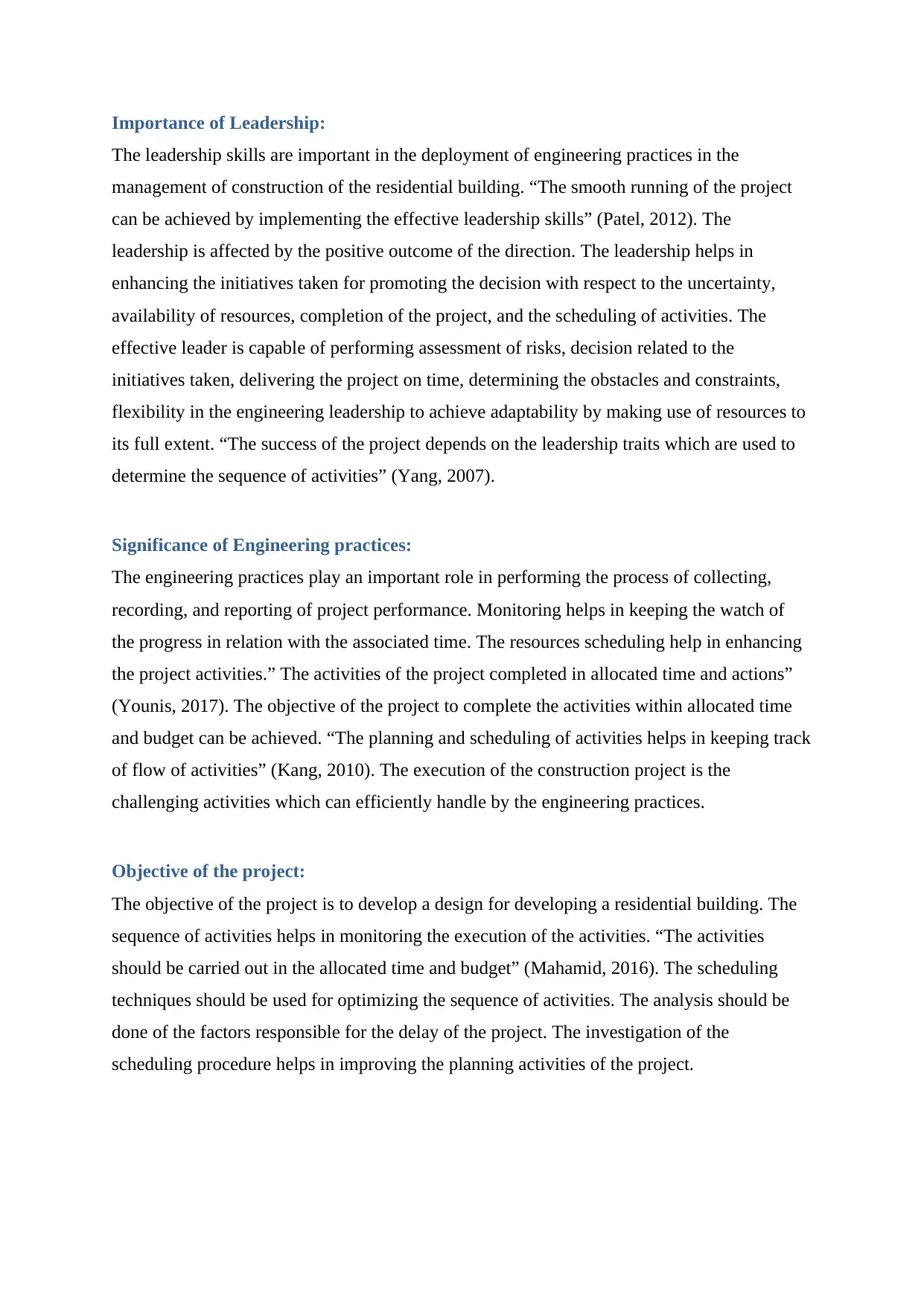
Importance of Leadership:
The leadership skills are important in the deployment of engineering practices in the
management of construction of the residential building. “The smooth running of the project
can be achieved by implementing the effective leadership skills” (Patel, 2012). The
leadership is affected by the positive outcome of the direction. The leadership helps in
enhancing the initiatives taken for promoting the decision with respect to the uncertainty,
availability of resources, completion of the project, and the scheduling of activities. The
effective leader is capable of performing assessment of risks, decision related to the
initiatives taken, delivering the project on time, determining the obstacles and constraints,
flexibility in the engineering leadership to achieve adaptability by making use of resources to
its full extent. “The success of the project depends on the leadership traits which are used to
determine the sequence of activities” (Yang, 2007).
Significance of Engineering practices:
The engineering practices play an important role in performing the process of collecting,
recording, and reporting of project performance. Monitoring helps in keeping the watch of
the progress in relation with the associated time. The resources scheduling help in enhancing
the project activities.” The activities of the project completed in allocated time and actions”
(Younis, 2017). The objective of the project to complete the activities within allocated time
and budget can be achieved. “The planning and scheduling of activities helps in keeping track
of flow of activities” (Kang, 2010). The execution of the construction project is the
challenging activities which can efficiently handle by the engineering practices.
Objective of the project:
The objective of the project is to develop a design for developing a residential building. The
sequence of activities helps in monitoring the execution of the activities. “The activities
should be carried out in the allocated time and budget” (Mahamid, 2016). The scheduling
techniques should be used for optimizing the sequence of activities. The analysis should be
done of the factors responsible for the delay of the project. The investigation of the
scheduling procedure helps in improving the planning activities of the project.
The leadership skills are important in the deployment of engineering practices in the
management of construction of the residential building. “The smooth running of the project
can be achieved by implementing the effective leadership skills” (Patel, 2012). The
leadership is affected by the positive outcome of the direction. The leadership helps in
enhancing the initiatives taken for promoting the decision with respect to the uncertainty,
availability of resources, completion of the project, and the scheduling of activities. The
effective leader is capable of performing assessment of risks, decision related to the
initiatives taken, delivering the project on time, determining the obstacles and constraints,
flexibility in the engineering leadership to achieve adaptability by making use of resources to
its full extent. “The success of the project depends on the leadership traits which are used to
determine the sequence of activities” (Yang, 2007).
Significance of Engineering practices:
The engineering practices play an important role in performing the process of collecting,
recording, and reporting of project performance. Monitoring helps in keeping the watch of
the progress in relation with the associated time. The resources scheduling help in enhancing
the project activities.” The activities of the project completed in allocated time and actions”
(Younis, 2017). The objective of the project to complete the activities within allocated time
and budget can be achieved. “The planning and scheduling of activities helps in keeping track
of flow of activities” (Kang, 2010). The execution of the construction project is the
challenging activities which can efficiently handle by the engineering practices.
Objective of the project:
The objective of the project is to develop a design for developing a residential building. The
sequence of activities helps in monitoring the execution of the activities. “The activities
should be carried out in the allocated time and budget” (Mahamid, 2016). The scheduling
techniques should be used for optimizing the sequence of activities. The analysis should be
done of the factors responsible for the delay of the project. The investigation of the
scheduling procedure helps in improving the planning activities of the project.
Paraphrase This Document
Need a fresh take? Get an instant paraphrase of this document with our AI Paraphraser
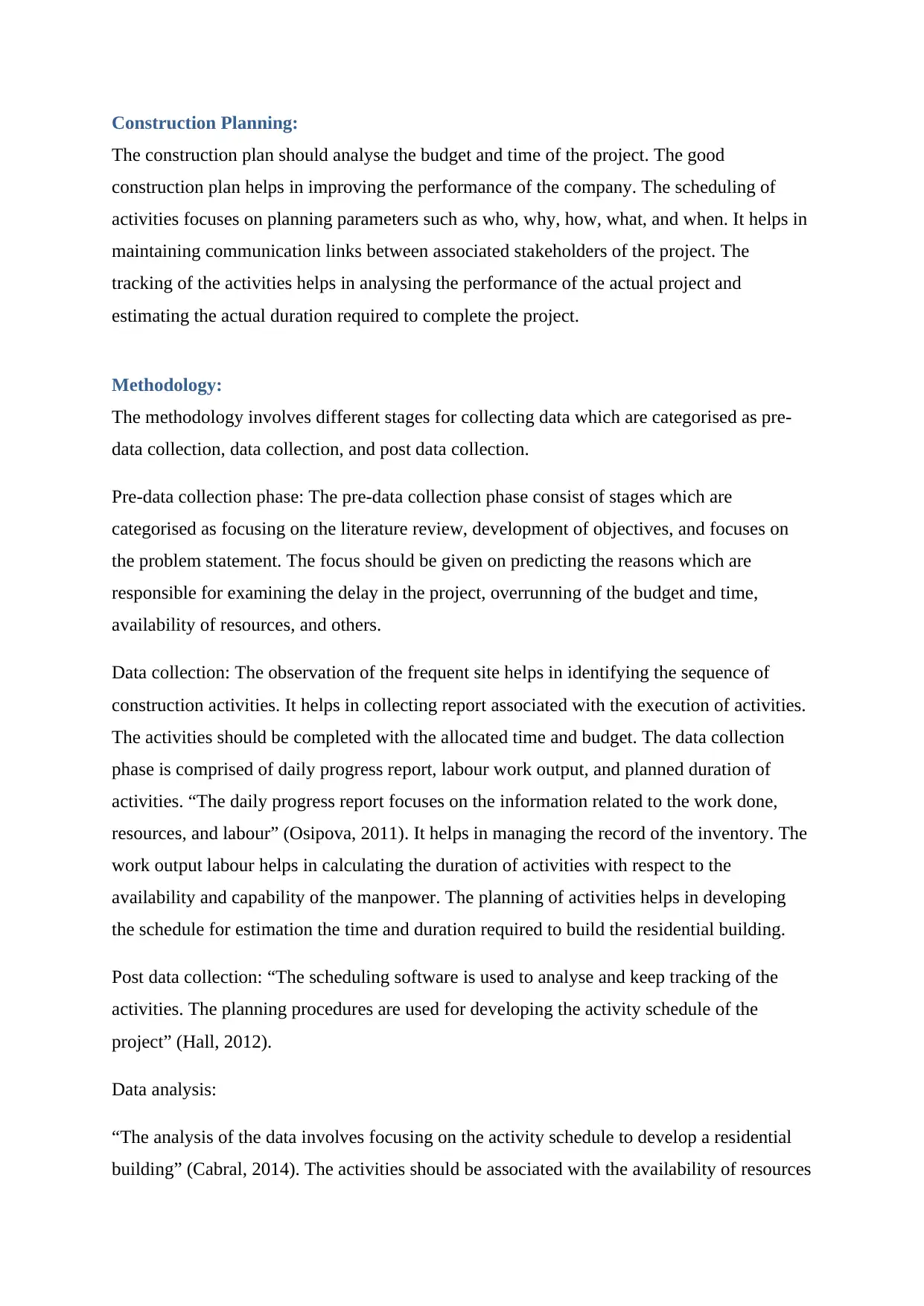
Construction Planning:
The construction plan should analyse the budget and time of the project. The good
construction plan helps in improving the performance of the company. The scheduling of
activities focuses on planning parameters such as who, why, how, what, and when. It helps in
maintaining communication links between associated stakeholders of the project. The
tracking of the activities helps in analysing the performance of the actual project and
estimating the actual duration required to complete the project.
Methodology:
The methodology involves different stages for collecting data which are categorised as pre-
data collection, data collection, and post data collection.
Pre-data collection phase: The pre-data collection phase consist of stages which are
categorised as focusing on the literature review, development of objectives, and focuses on
the problem statement. The focus should be given on predicting the reasons which are
responsible for examining the delay in the project, overrunning of the budget and time,
availability of resources, and others.
Data collection: The observation of the frequent site helps in identifying the sequence of
construction activities. It helps in collecting report associated with the execution of activities.
The activities should be completed with the allocated time and budget. The data collection
phase is comprised of daily progress report, labour work output, and planned duration of
activities. “The daily progress report focuses on the information related to the work done,
resources, and labour” (Osipova, 2011). It helps in managing the record of the inventory. The
work output labour helps in calculating the duration of activities with respect to the
availability and capability of the manpower. The planning of activities helps in developing
the schedule for estimation the time and duration required to build the residential building.
Post data collection: “The scheduling software is used to analyse and keep tracking of the
activities. The planning procedures are used for developing the activity schedule of the
project” (Hall, 2012).
Data analysis:
“The analysis of the data involves focusing on the activity schedule to develop a residential
building” (Cabral, 2014). The activities should be associated with the availability of resources
The construction plan should analyse the budget and time of the project. The good
construction plan helps in improving the performance of the company. The scheduling of
activities focuses on planning parameters such as who, why, how, what, and when. It helps in
maintaining communication links between associated stakeholders of the project. The
tracking of the activities helps in analysing the performance of the actual project and
estimating the actual duration required to complete the project.
Methodology:
The methodology involves different stages for collecting data which are categorised as pre-
data collection, data collection, and post data collection.
Pre-data collection phase: The pre-data collection phase consist of stages which are
categorised as focusing on the literature review, development of objectives, and focuses on
the problem statement. The focus should be given on predicting the reasons which are
responsible for examining the delay in the project, overrunning of the budget and time,
availability of resources, and others.
Data collection: The observation of the frequent site helps in identifying the sequence of
construction activities. It helps in collecting report associated with the execution of activities.
The activities should be completed with the allocated time and budget. The data collection
phase is comprised of daily progress report, labour work output, and planned duration of
activities. “The daily progress report focuses on the information related to the work done,
resources, and labour” (Osipova, 2011). It helps in managing the record of the inventory. The
work output labour helps in calculating the duration of activities with respect to the
availability and capability of the manpower. The planning of activities helps in developing
the schedule for estimation the time and duration required to build the residential building.
Post data collection: “The scheduling software is used to analyse and keep tracking of the
activities. The planning procedures are used for developing the activity schedule of the
project” (Hall, 2012).
Data analysis:
“The analysis of the data involves focusing on the activity schedule to develop a residential
building” (Cabral, 2014). The activities should be associated with the availability of resources
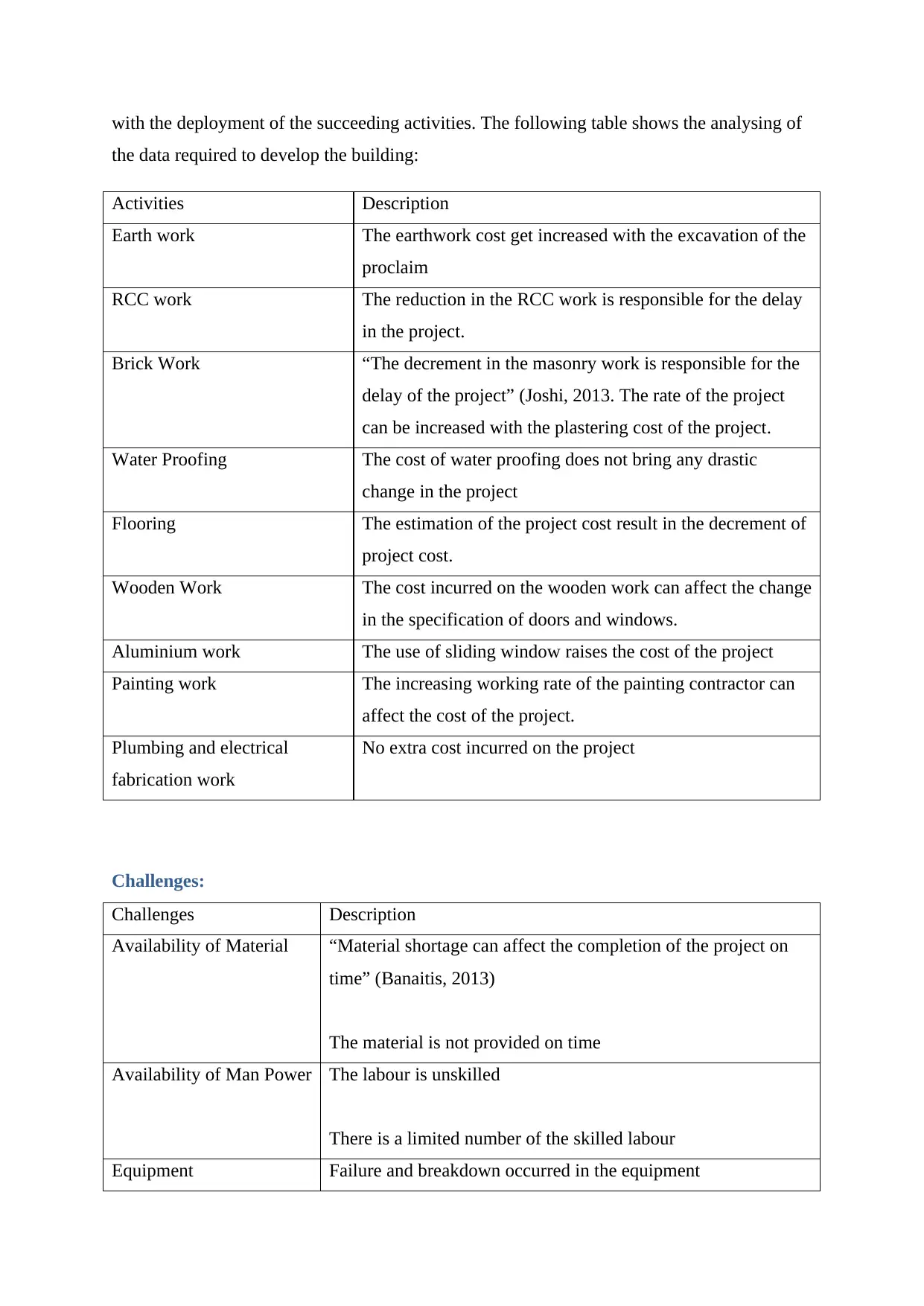
with the deployment of the succeeding activities. The following table shows the analysing of
the data required to develop the building:
Activities Description
Earth work The earthwork cost get increased with the excavation of the
proclaim
RCC work The reduction in the RCC work is responsible for the delay
in the project.
Brick Work “The decrement in the masonry work is responsible for the
delay of the project” (Joshi, 2013. The rate of the project
can be increased with the plastering cost of the project.
Water Proofing The cost of water proofing does not bring any drastic
change in the project
Flooring The estimation of the project cost result in the decrement of
project cost.
Wooden Work The cost incurred on the wooden work can affect the change
in the specification of doors and windows.
Aluminium work The use of sliding window raises the cost of the project
Painting work The increasing working rate of the painting contractor can
affect the cost of the project.
Plumbing and electrical
fabrication work
No extra cost incurred on the project
Challenges:
Challenges Description
Availability of Material “Material shortage can affect the completion of the project on
time” (Banaitis, 2013)
The material is not provided on time
Availability of Man Power The labour is unskilled
There is a limited number of the skilled labour
Equipment Failure and breakdown occurred in the equipment
the data required to develop the building:
Activities Description
Earth work The earthwork cost get increased with the excavation of the
proclaim
RCC work The reduction in the RCC work is responsible for the delay
in the project.
Brick Work “The decrement in the masonry work is responsible for the
delay of the project” (Joshi, 2013. The rate of the project
can be increased with the plastering cost of the project.
Water Proofing The cost of water proofing does not bring any drastic
change in the project
Flooring The estimation of the project cost result in the decrement of
project cost.
Wooden Work The cost incurred on the wooden work can affect the change
in the specification of doors and windows.
Aluminium work The use of sliding window raises the cost of the project
Painting work The increasing working rate of the painting contractor can
affect the cost of the project.
Plumbing and electrical
fabrication work
No extra cost incurred on the project
Challenges:
Challenges Description
Availability of Material “Material shortage can affect the completion of the project on
time” (Banaitis, 2013)
The material is not provided on time
Availability of Man Power The labour is unskilled
There is a limited number of the skilled labour
Equipment Failure and breakdown occurred in the equipment
⊘ This is a preview!⊘
Do you want full access?
Subscribe today to unlock all pages.

Trusted by 1+ million students worldwide
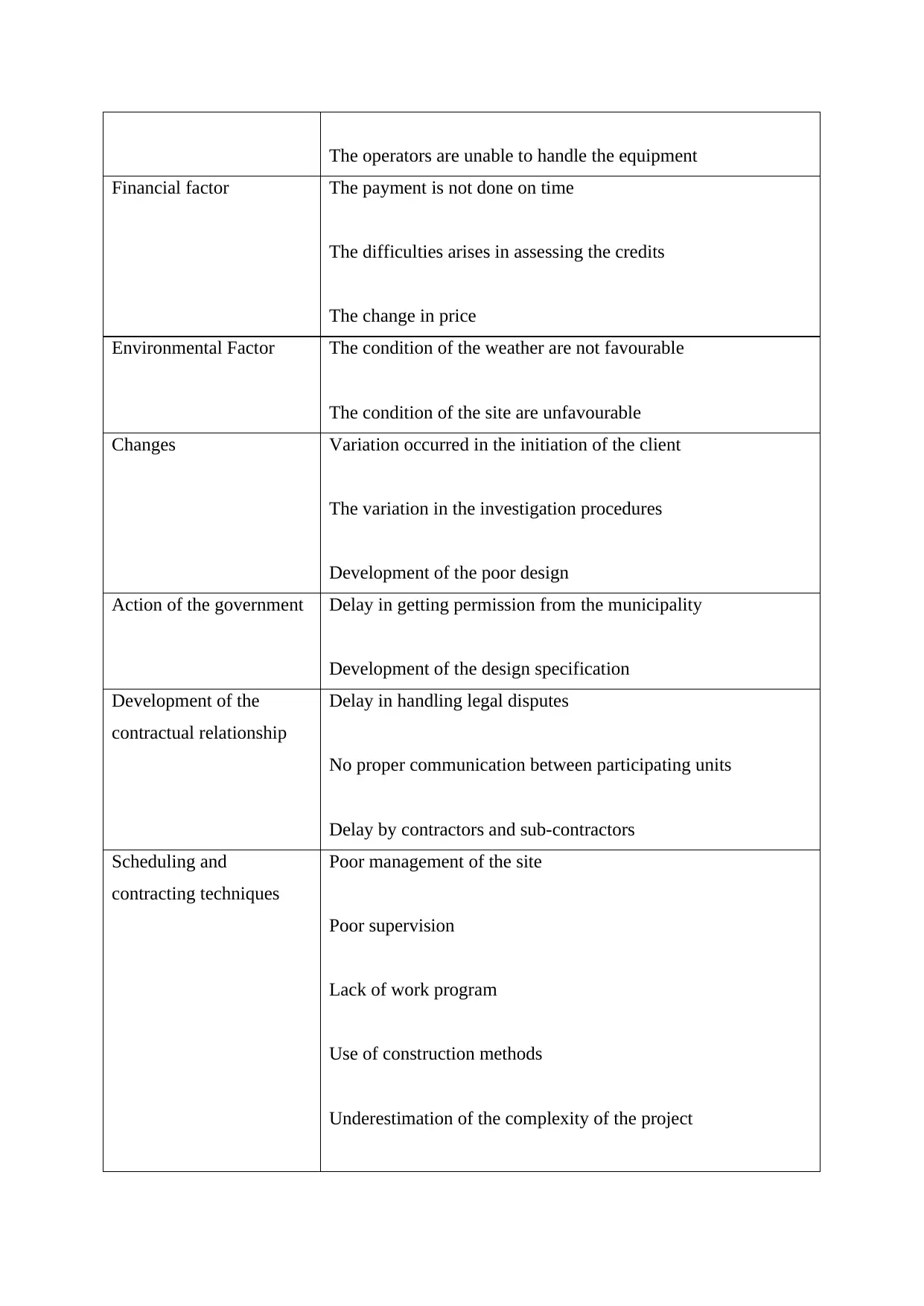
The operators are unable to handle the equipment
Financial factor The payment is not done on time
The difficulties arises in assessing the credits
The change in price
Environmental Factor The condition of the weather are not favourable
The condition of the site are unfavourable
Changes Variation occurred in the initiation of the client
The variation in the investigation procedures
Development of the poor design
Action of the government Delay in getting permission from the municipality
Development of the design specification
Development of the
contractual relationship
Delay in handling legal disputes
No proper communication between participating units
Delay by contractors and sub-contractors
Scheduling and
contracting techniques
Poor management of the site
Poor supervision
Lack of work program
Use of construction methods
Underestimation of the complexity of the project
Financial factor The payment is not done on time
The difficulties arises in assessing the credits
The change in price
Environmental Factor The condition of the weather are not favourable
The condition of the site are unfavourable
Changes Variation occurred in the initiation of the client
The variation in the investigation procedures
Development of the poor design
Action of the government Delay in getting permission from the municipality
Development of the design specification
Development of the
contractual relationship
Delay in handling legal disputes
No proper communication between participating units
Delay by contractors and sub-contractors
Scheduling and
contracting techniques
Poor management of the site
Poor supervision
Lack of work program
Use of construction methods
Underestimation of the complexity of the project
Paraphrase This Document
Need a fresh take? Get an instant paraphrase of this document with our AI Paraphraser
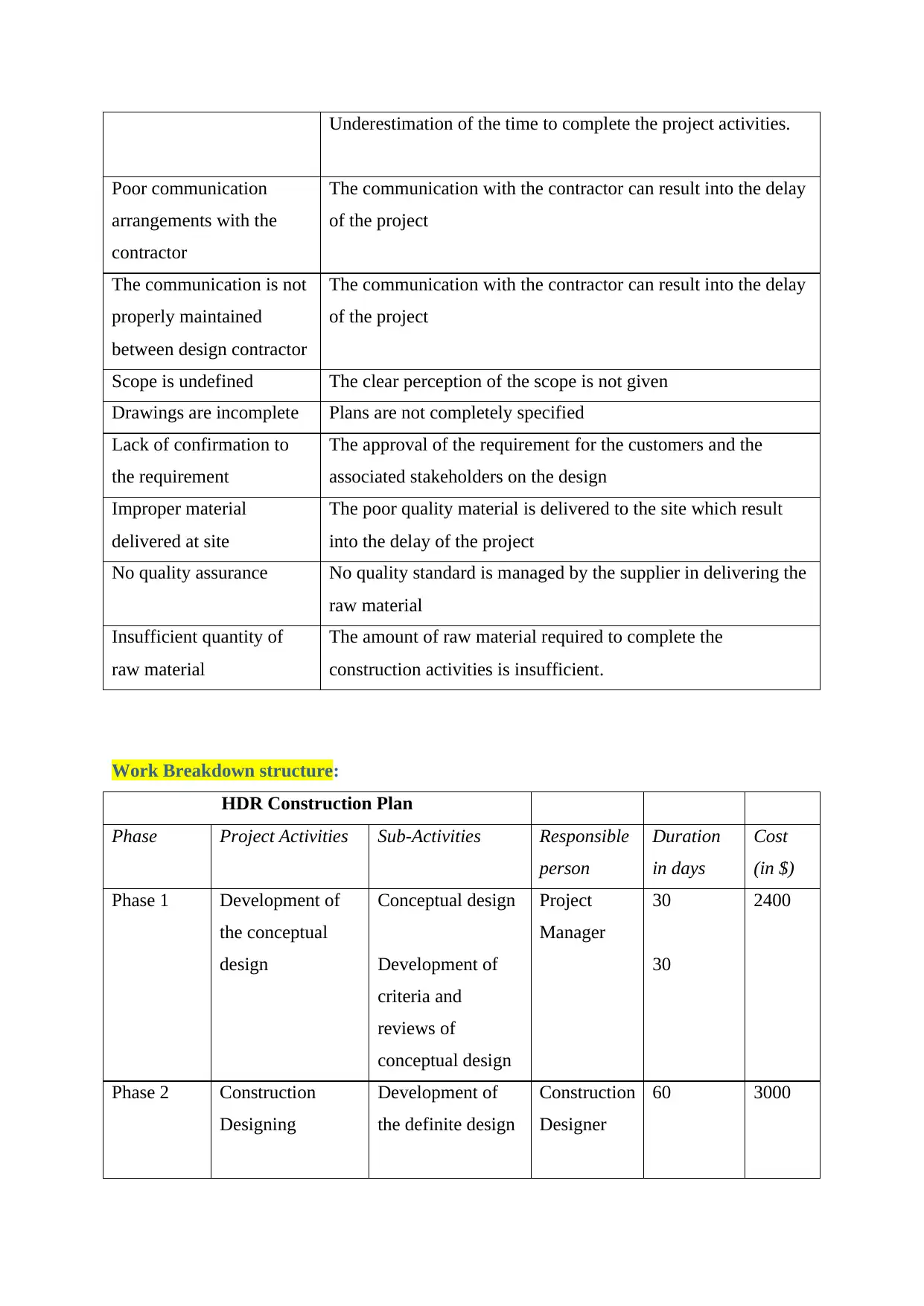
Underestimation of the time to complete the project activities.
Poor communication
arrangements with the
contractor
The communication with the contractor can result into the delay
of the project
The communication is not
properly maintained
between design contractor
The communication with the contractor can result into the delay
of the project
Scope is undefined The clear perception of the scope is not given
Drawings are incomplete Plans are not completely specified
Lack of confirmation to
the requirement
The approval of the requirement for the customers and the
associated stakeholders on the design
Improper material
delivered at site
The poor quality material is delivered to the site which result
into the delay of the project
No quality assurance No quality standard is managed by the supplier in delivering the
raw material
Insufficient quantity of
raw material
The amount of raw material required to complete the
construction activities is insufficient.
Work Breakdown structure:
HDR Construction Plan
Phase Project Activities Sub-Activities Responsible
person
Duration
in days
Cost
(in $)
Phase 1 Development of
the conceptual
design
Conceptual design
Development of
criteria and
reviews of
conceptual design
Project
Manager
30
30
2400
Phase 2 Construction
Designing
Development of
the definite design
Construction
Designer
60 3000
Poor communication
arrangements with the
contractor
The communication with the contractor can result into the delay
of the project
The communication is not
properly maintained
between design contractor
The communication with the contractor can result into the delay
of the project
Scope is undefined The clear perception of the scope is not given
Drawings are incomplete Plans are not completely specified
Lack of confirmation to
the requirement
The approval of the requirement for the customers and the
associated stakeholders on the design
Improper material
delivered at site
The poor quality material is delivered to the site which result
into the delay of the project
No quality assurance No quality standard is managed by the supplier in delivering the
raw material
Insufficient quantity of
raw material
The amount of raw material required to complete the
construction activities is insufficient.
Work Breakdown structure:
HDR Construction Plan
Phase Project Activities Sub-Activities Responsible
person
Duration
in days
Cost
(in $)
Phase 1 Development of
the conceptual
design
Conceptual design
Development of
criteria and
reviews of
conceptual design
Project
Manager
30
30
2400
Phase 2 Construction
Designing
Development of
the definite design
Construction
Designer
60 3000
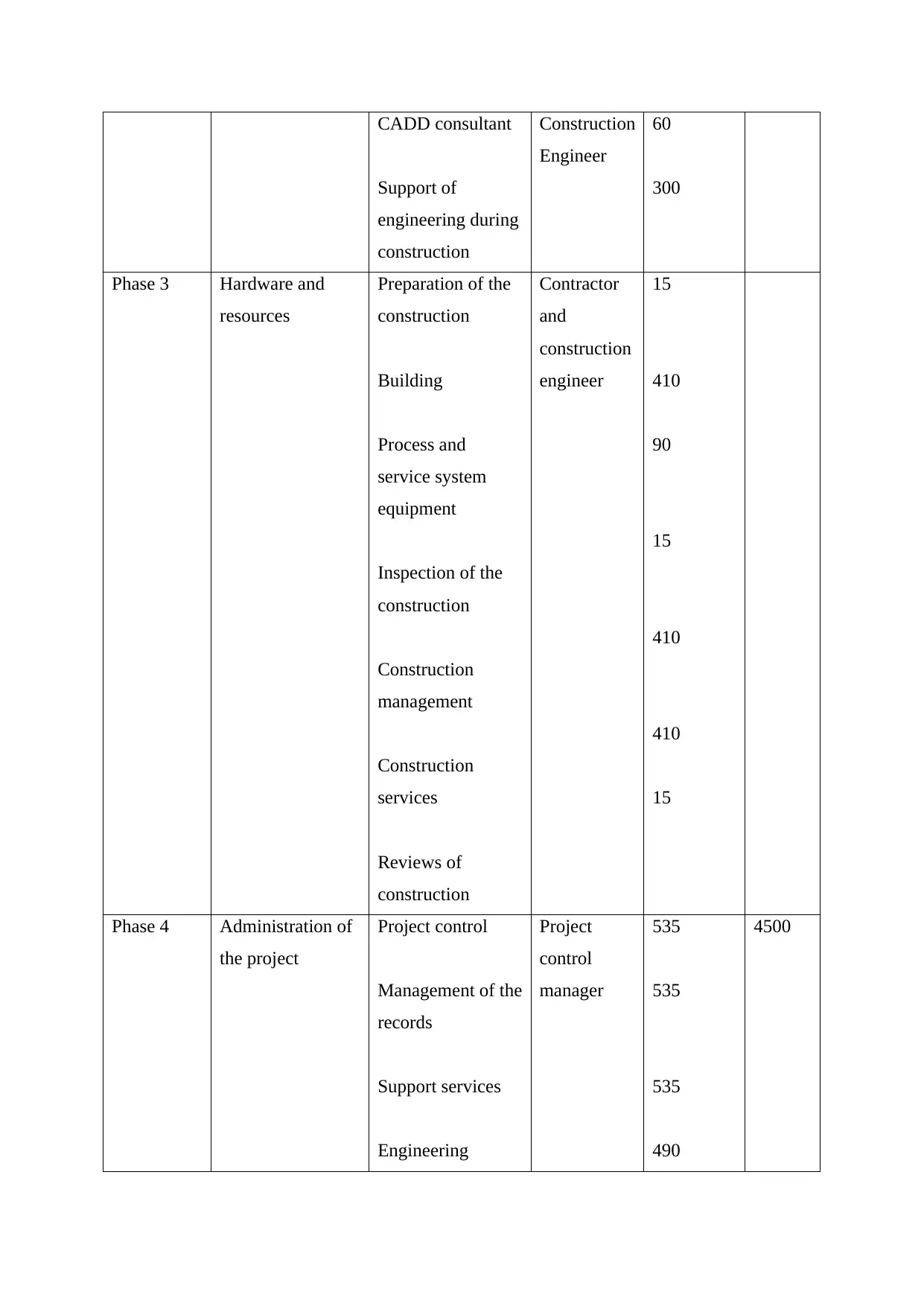
CADD consultant
Support of
engineering during
construction
Construction
Engineer
60
300
Phase 3 Hardware and
resources
Preparation of the
construction
Building
Process and
service system
equipment
Inspection of the
construction
Construction
management
Construction
services
Reviews of
construction
Contractor
and
construction
engineer
15
410
90
15
410
410
15
Phase 4 Administration of
the project
Project control
Management of the
records
Support services
Engineering
Project
control
manager
535
535
535
490
4500
Support of
engineering during
construction
Construction
Engineer
60
300
Phase 3 Hardware and
resources
Preparation of the
construction
Building
Process and
service system
equipment
Inspection of the
construction
Construction
management
Construction
services
Reviews of
construction
Contractor
and
construction
engineer
15
410
90
15
410
410
15
Phase 4 Administration of
the project
Project control
Management of the
records
Support services
Engineering
Project
control
manager
535
535
535
490
4500
⊘ This is a preview!⊘
Do you want full access?
Subscribe today to unlock all pages.

Trusted by 1+ million students worldwide
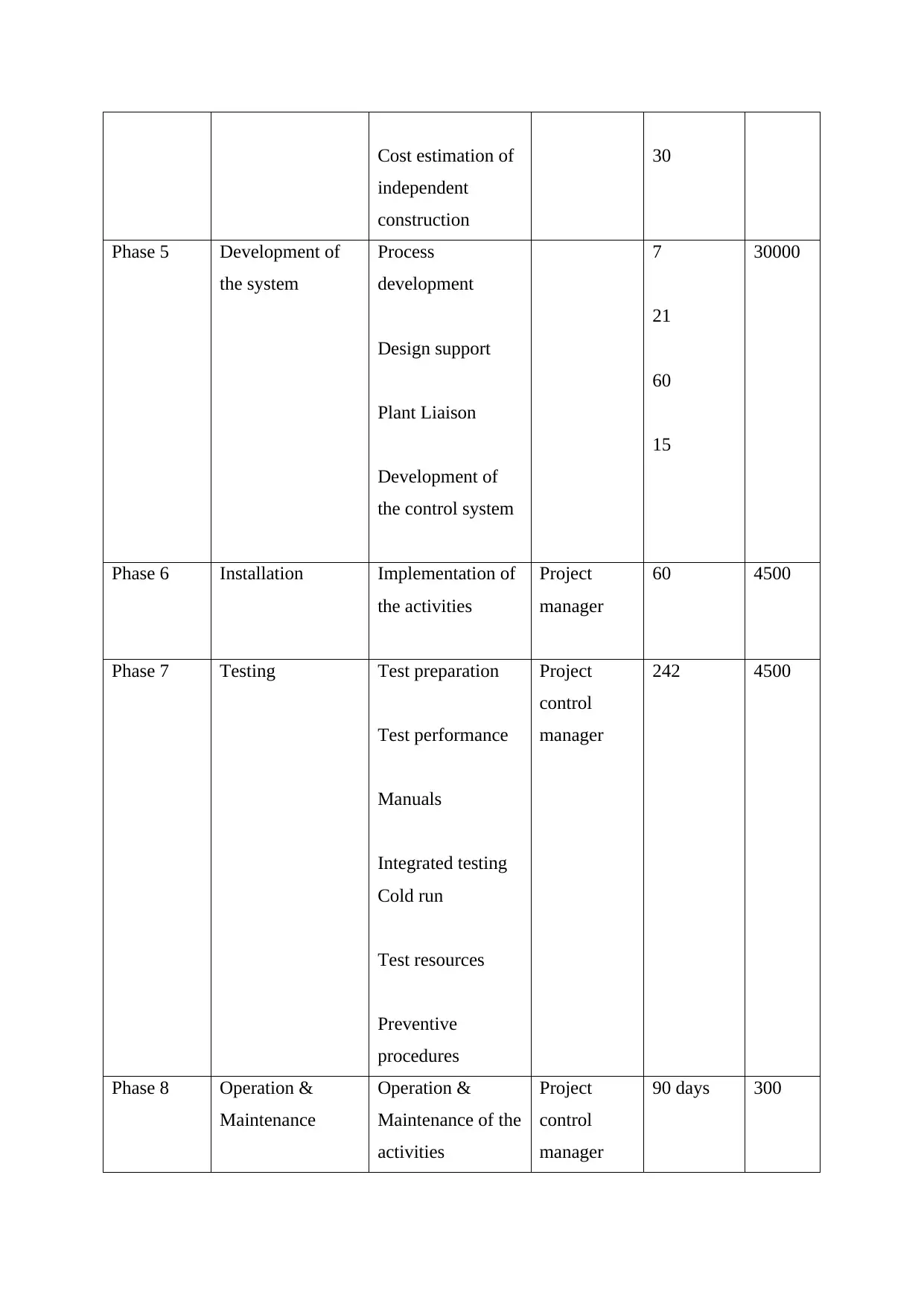
Cost estimation of
independent
construction
30
Phase 5 Development of
the system
Process
development
Design support
Plant Liaison
Development of
the control system
7
21
60
15
30000
Phase 6 Installation Implementation of
the activities
Project
manager
60 4500
Phase 7 Testing Test preparation
Test performance
Manuals
Integrated testing
Cold run
Test resources
Preventive
procedures
Project
control
manager
242 4500
Phase 8 Operation &
Maintenance
Operation &
Maintenance of the
activities
Project
control
manager
90 days 300
independent
construction
30
Phase 5 Development of
the system
Process
development
Design support
Plant Liaison
Development of
the control system
7
21
60
15
30000
Phase 6 Installation Implementation of
the activities
Project
manager
60 4500
Phase 7 Testing Test preparation
Test performance
Manuals
Integrated testing
Cold run
Test resources
Preventive
procedures
Project
control
manager
242 4500
Phase 8 Operation &
Maintenance
Operation &
Maintenance of the
activities
Project
control
manager
90 days 300
Paraphrase This Document
Need a fresh take? Get an instant paraphrase of this document with our AI Paraphraser
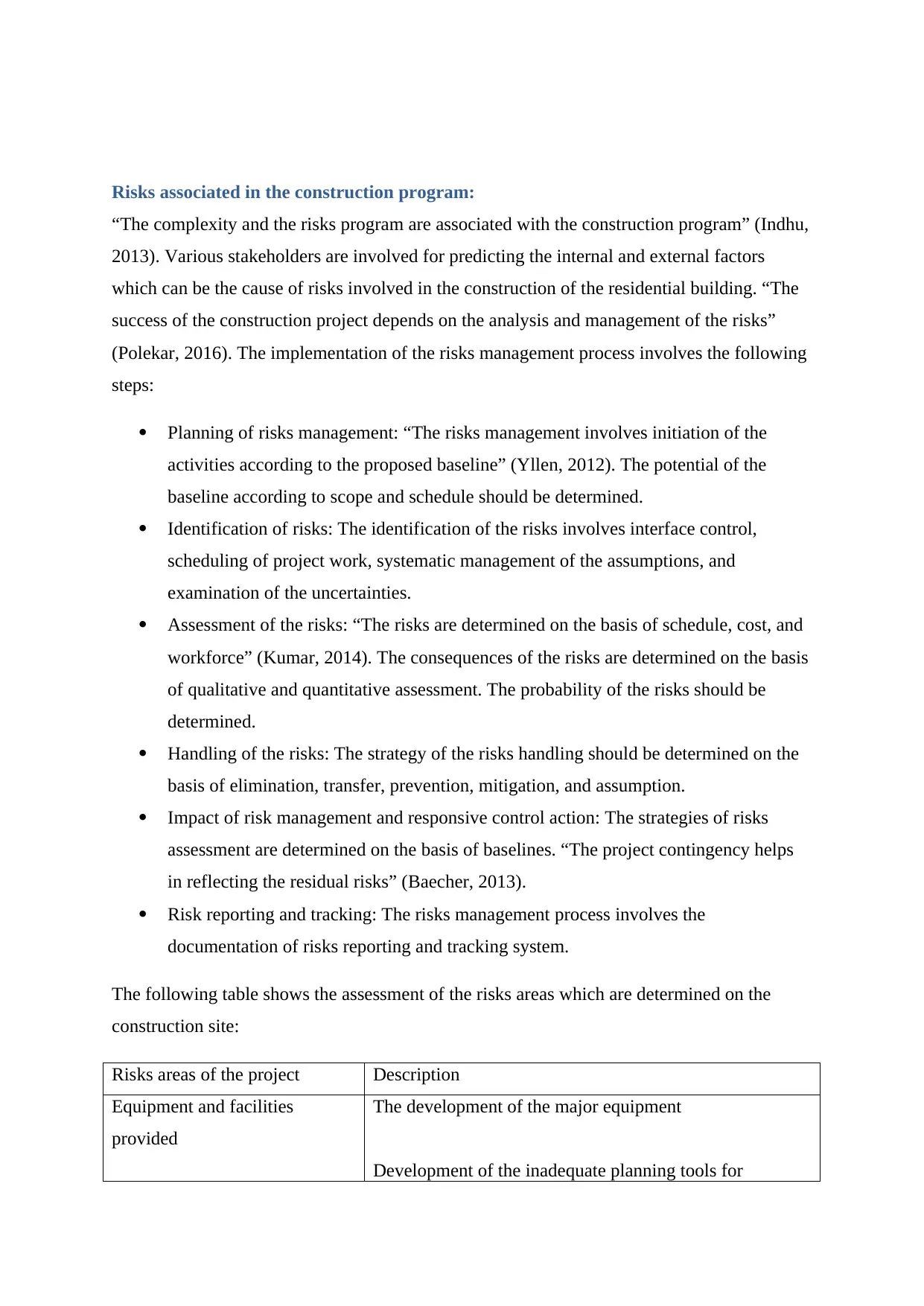
Risks associated in the construction program:
“The complexity and the risks program are associated with the construction program” (Indhu,
2013). Various stakeholders are involved for predicting the internal and external factors
which can be the cause of risks involved in the construction of the residential building. “The
success of the construction project depends on the analysis and management of the risks”
(Polekar, 2016). The implementation of the risks management process involves the following
steps:
Planning of risks management: “The risks management involves initiation of the
activities according to the proposed baseline” (Yllen, 2012). The potential of the
baseline according to scope and schedule should be determined.
Identification of risks: The identification of the risks involves interface control,
scheduling of project work, systematic management of the assumptions, and
examination of the uncertainties.
Assessment of the risks: “The risks are determined on the basis of schedule, cost, and
workforce” (Kumar, 2014). The consequences of the risks are determined on the basis
of qualitative and quantitative assessment. The probability of the risks should be
determined.
Handling of the risks: The strategy of the risks handling should be determined on the
basis of elimination, transfer, prevention, mitigation, and assumption.
Impact of risk management and responsive control action: The strategies of risks
assessment are determined on the basis of baselines. “The project contingency helps
in reflecting the residual risks” (Baecher, 2013).
Risk reporting and tracking: The risks management process involves the
documentation of risks reporting and tracking system.
The following table shows the assessment of the risks areas which are determined on the
construction site:
Risks areas of the project Description
Equipment and facilities
provided
The development of the major equipment
Development of the inadequate planning tools for
“The complexity and the risks program are associated with the construction program” (Indhu,
2013). Various stakeholders are involved for predicting the internal and external factors
which can be the cause of risks involved in the construction of the residential building. “The
success of the construction project depends on the analysis and management of the risks”
(Polekar, 2016). The implementation of the risks management process involves the following
steps:
Planning of risks management: “The risks management involves initiation of the
activities according to the proposed baseline” (Yllen, 2012). The potential of the
baseline according to scope and schedule should be determined.
Identification of risks: The identification of the risks involves interface control,
scheduling of project work, systematic management of the assumptions, and
examination of the uncertainties.
Assessment of the risks: “The risks are determined on the basis of schedule, cost, and
workforce” (Kumar, 2014). The consequences of the risks are determined on the basis
of qualitative and quantitative assessment. The probability of the risks should be
determined.
Handling of the risks: The strategy of the risks handling should be determined on the
basis of elimination, transfer, prevention, mitigation, and assumption.
Impact of risk management and responsive control action: The strategies of risks
assessment are determined on the basis of baselines. “The project contingency helps
in reflecting the residual risks” (Baecher, 2013).
Risk reporting and tracking: The risks management process involves the
documentation of risks reporting and tracking system.
The following table shows the assessment of the risks areas which are determined on the
construction site:
Risks areas of the project Description
Equipment and facilities
provided
The development of the major equipment
Development of the inadequate planning tools for
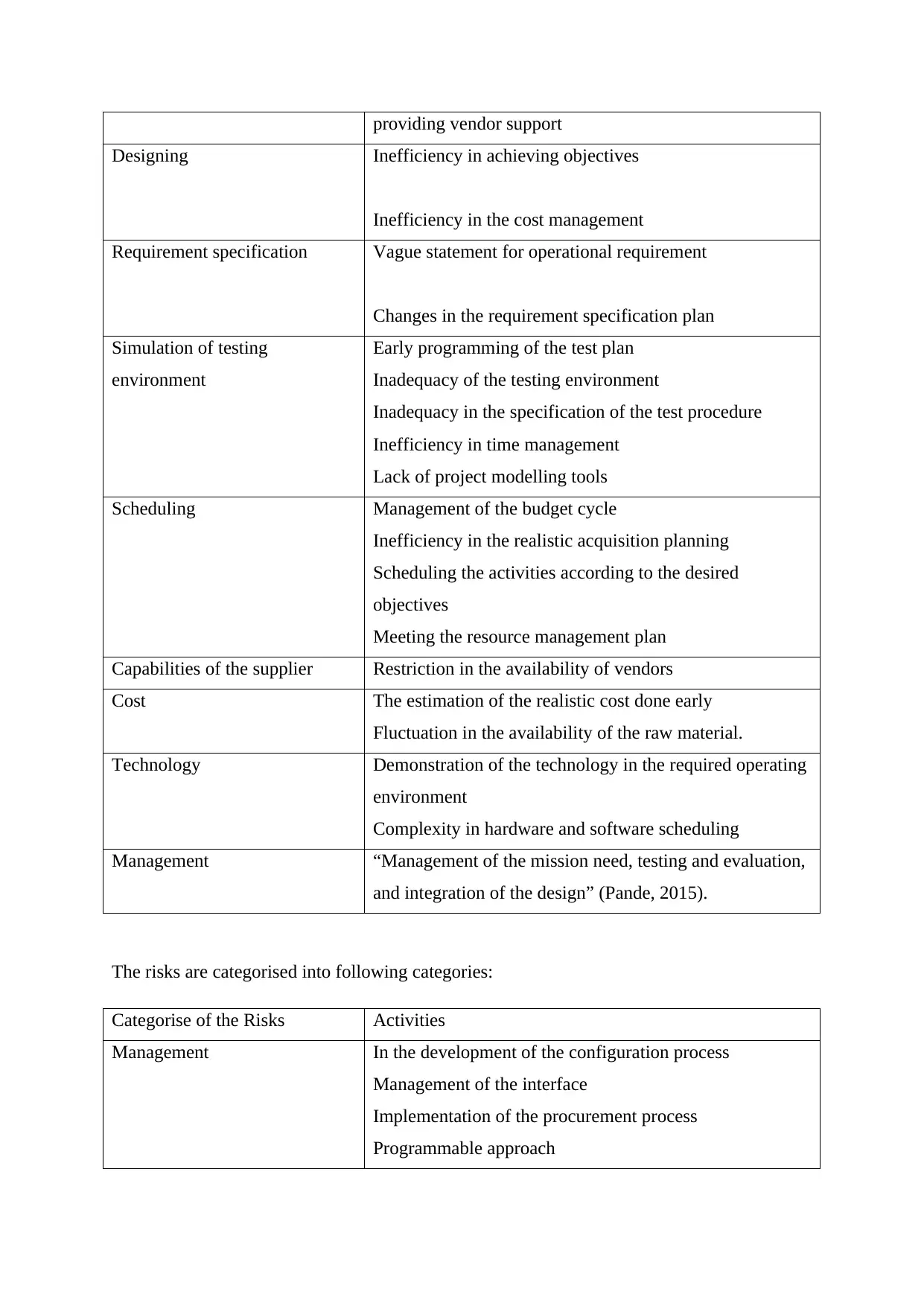
providing vendor support
Designing Inefficiency in achieving objectives
Inefficiency in the cost management
Requirement specification Vague statement for operational requirement
Changes in the requirement specification plan
Simulation of testing
environment
Early programming of the test plan
Inadequacy of the testing environment
Inadequacy in the specification of the test procedure
Inefficiency in time management
Lack of project modelling tools
Scheduling Management of the budget cycle
Inefficiency in the realistic acquisition planning
Scheduling the activities according to the desired
objectives
Meeting the resource management plan
Capabilities of the supplier Restriction in the availability of vendors
Cost The estimation of the realistic cost done early
Fluctuation in the availability of the raw material.
Technology Demonstration of the technology in the required operating
environment
Complexity in hardware and software scheduling
Management “Management of the mission need, testing and evaluation,
and integration of the design” (Pande, 2015).
The risks are categorised into following categories:
Categorise of the Risks Activities
Management In the development of the configuration process
Management of the interface
Implementation of the procurement process
Programmable approach
Designing Inefficiency in achieving objectives
Inefficiency in the cost management
Requirement specification Vague statement for operational requirement
Changes in the requirement specification plan
Simulation of testing
environment
Early programming of the test plan
Inadequacy of the testing environment
Inadequacy in the specification of the test procedure
Inefficiency in time management
Lack of project modelling tools
Scheduling Management of the budget cycle
Inefficiency in the realistic acquisition planning
Scheduling the activities according to the desired
objectives
Meeting the resource management plan
Capabilities of the supplier Restriction in the availability of vendors
Cost The estimation of the realistic cost done early
Fluctuation in the availability of the raw material.
Technology Demonstration of the technology in the required operating
environment
Complexity in hardware and software scheduling
Management “Management of the mission need, testing and evaluation,
and integration of the design” (Pande, 2015).
The risks are categorised into following categories:
Categorise of the Risks Activities
Management In the development of the configuration process
Management of the interface
Implementation of the procurement process
Programmable approach
⊘ This is a preview!⊘
Do you want full access?
Subscribe today to unlock all pages.

Trusted by 1+ million students worldwide
1 out of 21
Related Documents
Your All-in-One AI-Powered Toolkit for Academic Success.
+13062052269
info@desklib.com
Available 24*7 on WhatsApp / Email
![[object Object]](/_next/static/media/star-bottom.7253800d.svg)
Unlock your academic potential
Copyright © 2020–2025 A2Z Services. All Rights Reserved. Developed and managed by ZUCOL.





